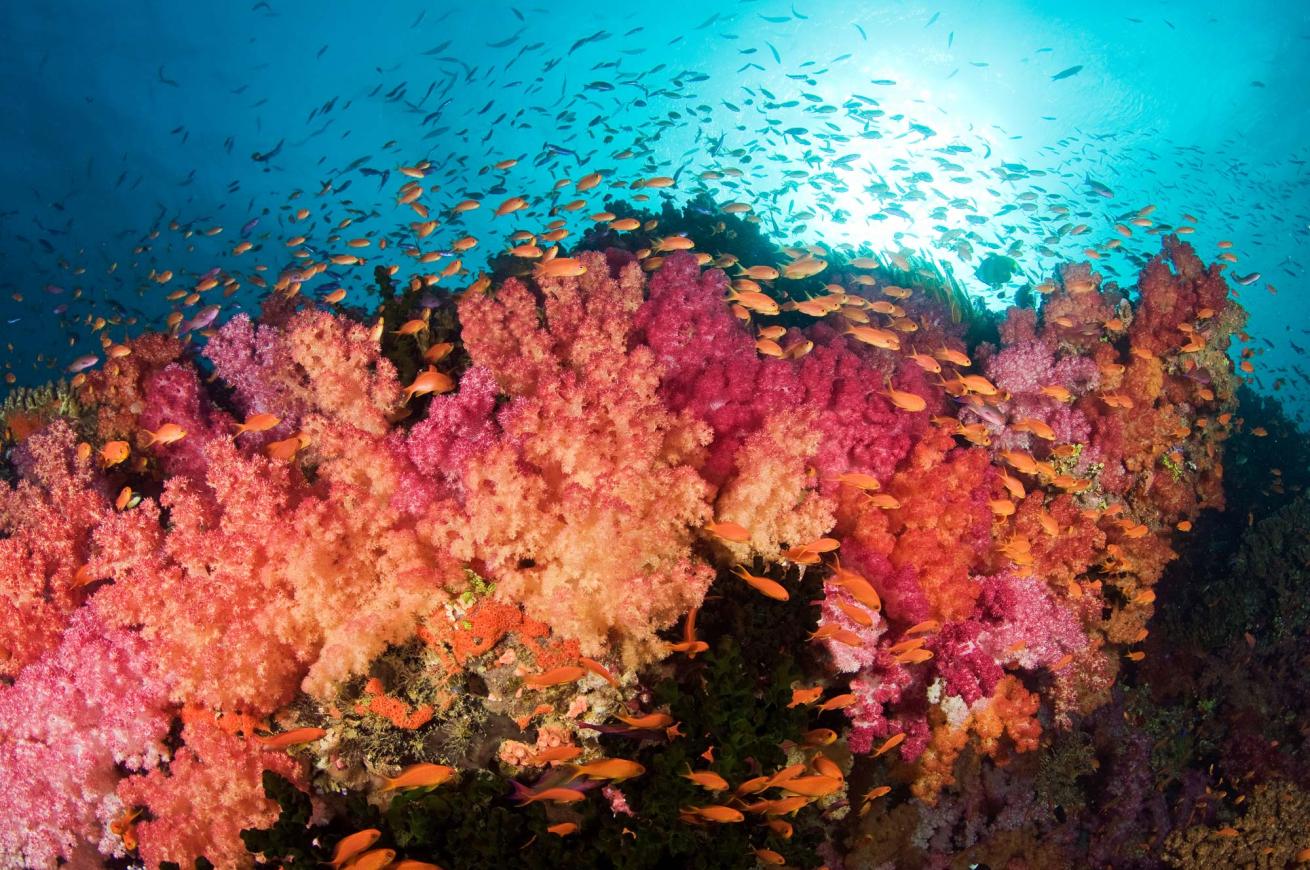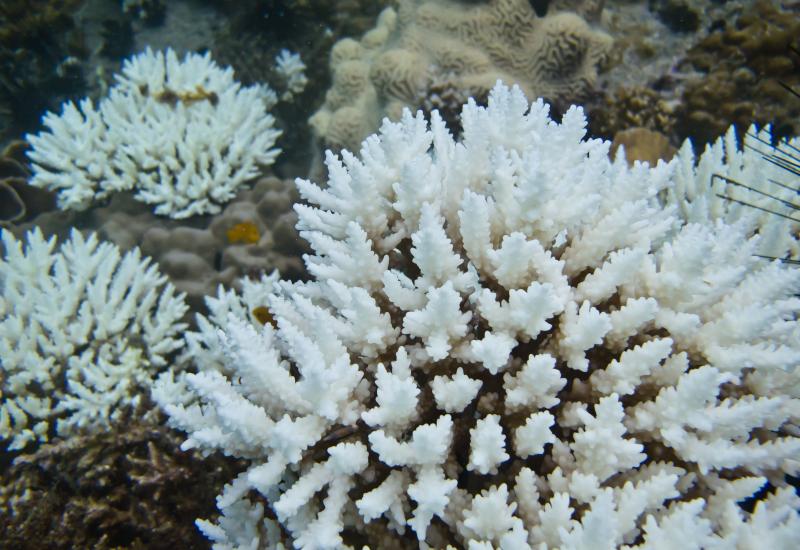Anchors Away: How Fiji Saved Its Reefs

Fiji Soft Coral
Jim Patterson
Imagine you’re diving in warm, clear water along a 1,000-foot vertical wall of multicolored coral, dotted with thousands of curious fish. Schools of tuna and trevally streak by while a humpback surfaces in the distance. An endangered hawksbill turtle glides past you, and a blue ribbon eel peeks out of his cave.
Are you ready to buy your plane ticket?
Spanning the sea between Fiji’s two largest islands — Viti Levu and Vanua Levu — the Namena Marine Reserve showcases some of the world’s most spectacular tropical coral reefs. It also sustains the people of Kubulau, whose ancestors have fished these reefs for centuries. In the 1980s and ’90s, this vibrant ecosystem was threatened by rampant commercial fishing. Fish populations were declining, and Kubulau’s primary source of sustenance and income was disappearing. To halt the decline, chiefs from each of Kubulau’s 10 villages banded together to declare the area a no-take zone — the first in Fiji.
Today, the 70-square-kilometer marine protected area is “the marine equivalent of the Serengeti,” says Rick MacPherson, conservation programs director at the Coral Reef Alliance (CORAL, coral.org). Tourism is flourishing, with nearly 1,200 divers visiting Namena each year, and diving fees are fueling reserve management and community development.
As the number of divers increased, however, local leaders began to worry that the tourists they were relying on to conserve the reefs might actually be harming them. Existing mooring buoys proved insufficient to handle the increasing tourist traffic within the reserve. As a result, heavy anchors, primarily from live-aboards, were crushing coral and leaving them vulnerable to infection.
In response, the Kubulau community teamed with its long-time conservation partners to devise a solution to protect the reef and avert anchor damage. CORAL, an international nonprofit dedicated to uniting communities to save coral reefs, had already been working with the community. Now, they joined with Kubulau chiefs and the Kubulau Resource Management Committee to create Fiji’s first anchor-free zone within Namena. Together, they mapped out locations for a series of permanent moorings within the reserve; six deepwater moorings serve popular dive sites, and three nearshore moorings enable tourist visits to Kiobo village. All mooring buoys are open to both tour operators and private vessels.
 CORAL raised more than $40,000 for the installation of the moorings and granted it to partner dive operators. They agreed to maintain deepwater moorings while the Kubulau community services those near shore. Dive and maintenance training was provided to the Kubulau community members selected for these roles.
CORAL raised more than $40,000 for the installation of the moorings and granted it to partner dive operators. They agreed to maintain deepwater moorings while the Kubulau community services those near shore. Dive and maintenance training was provided to the Kubulau community members selected for these roles.
To better enable villagers living closest to the nearshore moorings to capitalize on increased tourist visitation, CORAL and its partners orchestrated business workshops for key community members. Participants learned to conduct tourism feasibility studies, write business proposals, create budgets and develop other skills. Since then, Kiobo community members have launched several ventures, including selling handmade woven products and leading visitors on guided jungle walks.
This has been an all-around success for the Namena Marine Reserve. Villagers get to meet divers and hear how others value their treasured resources, while divers appreciate learning about the Kubulau culture. The startup enterprises diversify the local economy and further reduce the possibility that Namena’s waters would again open to damaging commercial fishing.
The conservation accomplishments in Namena clearly show that protecting valuable natural resources can lead to both economic and social benefits, not just for today, but for generations to come.
Alexa Bach-McElrone is the interim communications manager at the Coral Reef Alliance in San Francisco, California.
For additional information about the Namena Marine Reserve, visit www.namena.org.

Jim Patterson
Imagine you’re diving in warm, clear water along a 1,000-foot vertical wall of multicolored coral, dotted with thousands of curious fish. Schools of tuna and trevally streak by while a humpback surfaces in the distance. An endangered hawksbill turtle glides past you, and a blue ribbon eel peeks out of his cave.
Are you ready to buy your plane ticket?
Spanning the sea between Fiji’s two largest islands — Viti Levu and Vanua Levu — the Namena Marine Reserve showcases some of the world’s most spectacular tropical coral reefs. It also sustains the people of Kubulau, whose ancestors have fished these reefs for centuries. In the 1980s and ’90s, this vibrant ecosystem was threatened by rampant commercial fishing. Fish populations were declining, and Kubulau’s primary source of sustenance and income was disappearing. To halt the decline, chiefs from each of Kubulau’s 10 villages banded together to declare the area a no-take zone — the first in Fiji.
Today, the 70-square-kilometer marine protected area is “the marine equivalent of the Serengeti,” says Rick MacPherson, conservation programs director at the Coral Reef Alliance (CORAL, coral.org). Tourism is flourishing, with nearly 1,200 divers visiting Namena each year, and diving fees are fueling reserve management and community development.
As the number of divers increased, however, local leaders began to worry that the tourists they were relying on to conserve the reefs might actually be harming them. Existing mooring buoys proved insufficient to handle the increasing tourist traffic within the reserve. As a result, heavy anchors, primarily from live-aboards, were crushing coral and leaving them vulnerable to infection.
In response, the Kubulau community teamed with its long-time conservation partners to devise a solution to protect the reef and avert anchor damage. CORAL, an international nonprofit dedicated to uniting communities to save coral reefs, had already been working with the community. Now, they joined with Kubulau chiefs and the Kubulau Resource Management Committee to create Fiji’s first anchor-free zone within Namena. Together, they mapped out locations for a series of permanent moorings within the reserve; six deepwater moorings serve popular dive sites, and three nearshore moorings enable tourist visits to Kiobo village. All mooring buoys are open to both tour operators and private vessels.
 CORAL raised more than $40,000 for the installation of the moorings and granted it to partner dive operators. They agreed to maintain deepwater moorings while the Kubulau community services those near shore. Dive and maintenance training was provided to the Kubulau community members selected for these roles.
CORAL raised more than $40,000 for the installation of the moorings and granted it to partner dive operators. They agreed to maintain deepwater moorings while the Kubulau community services those near shore. Dive and maintenance training was provided to the Kubulau community members selected for these roles.
To better enable villagers living closest to the nearshore moorings to capitalize on increased tourist visitation, CORAL and its partners orchestrated business workshops for key community members. Participants learned to conduct tourism feasibility studies, write business proposals, create budgets and develop other skills. Since then, Kiobo community members have launched several ventures, including selling handmade woven products and leading visitors on guided jungle walks.
This has been an all-around success for the Namena Marine Reserve. Villagers get to meet divers and hear how others value their treasured resources, while divers appreciate learning about the Kubulau culture. The startup enterprises diversify the local economy and further reduce the possibility that Namena’s waters would again open to damaging commercial fishing.
The conservation accomplishments in Namena clearly show that protecting valuable natural resources can lead to both economic and social benefits, not just for today, but for generations to come.
Alexa Bach-McElrone is the interim communications manager at the Coral Reef Alliance in San Francisco, California.
For additional information about the Namena Marine Reserve, visit www.namena.org.










